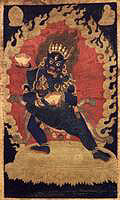
|
Tutelary Deity Yamantaka (painting no. 402)
|

View Larger Image |
||||||||||||||
|
Vajrabhairava, Sahaja Heruka (Tibetan: dor je jig je thung drag lhan chig kye pa, English: Spontaneously Arising Heruka Vajra Terror). Dark blue in colour with the head of a buffalo, three round eyes, two pointed horns - long and sharp, with the two hands at the heart holding a curved knife and skullcup he embraces the consort Vajra Vetali. Very fierce and wrathful with hair flowing upward like flame, he is adorned with a crown of five skulls, bone ornaments, a necklace of fifty freshly severed heads and wears the hide of an elephant. He stands with the right leg bent and the left straight above a sun disc and lotus seat. The consort Vajra Vetali with one face and two hands holds in the left a skullcup and with the right a curved knife held behind the head of Bhairava, standing on the right leg with the left embracing the waist of Bhairava. They are completely surrounded by the red rays and gold nimbus of the flames of pristine awareness. At the top left is the bodhisattva Manjushri with one face and two hands holding aloft the flaming sword of wisdom in the right and held to the heart the stem of an utpala blossom supporting the Prajnapamita sutra with the left. The tutelary deity Vajrabhairava is an emanation of the peaceful Manjushri. At the right is a seated lama wearing monastic robes and a pandita hat, a mendicant staff stands at the side. In Tantric iconography there are three common uses for the word 'heruka.' (1) In the Sarma traditions heruka generically conveys the meaning of a one faced, two-handed form of any complex male anuttarayoga deity. The principal form of the deities Vajrabhairava, Hevajra, Kalacakra, and the like, have multiple faces, hands and legs and the very essence, or essential form, is heruka, with one face and two hands. (2) In the Nyingmapa School the word generally refers to one of the Eight Sadhana Sections of Mahayoga Tantra such as Vajrakilaya, Samputa, etc. (3) Specific to the Gelugpa School heruka is used as an alternate name for the tutelary deity Cakrasamvara. Vajrabhairava, practiced in all the Sarma Schools, is an anuttarayoga tutelary deity of the father (method) classification. Of the many lineages to enter Tibet from India the most famous are those of Ra Lotsawa and Mal Lotsawa. With regard to the style of painting, the background is black and the foreground with the seat, flames and the two minor figures are gold filled. Vajrabhairava is painted with various earth pigments on a red backdrop with gold filaments of light extending out to the flames. The overall style can still be regarded as a 'ser thang' (gold [fill] scroll). J.Watt 6-98
|
|||||||||||||||
Photographed Image Copyright © 1998 Shelley & Donald Rubin Foundation
|
|
| |
Next Image |